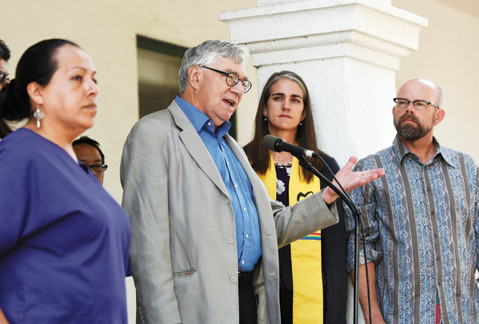Economy Up, Wages Down
Activists Prepare for Minimum Wage Hike Campaign

A rising tide allegedly lifts all boats, but thus far Santa Barbara’s economic recovery has failed to exert any upward pressure on the take-home pay of most hourly wage earners.
In fact, many Santa Barbara County workers making less than $30,000 a year have seen their hourly earnings actually decline since the Great Recession. In response, a group of high-profile community activists and S.B.-area labor unions congregated in front of City Hall Wednesday morning to highlight such findings in gory statistical detail. They’re hoping, they said, to kick-start “a community conversation” on ways to reduce the economic pain experienced by those squeezed between the South Coast’s notorious high cost of living and low-wage reality.
While the speakers — representing liberal-progressive organizations like CAUSE (Central Coast Alliance United for a Sustainable Economy), SBCAN (S.B. County Action Network), and CLUE (Clergy and Laity United for Economic Justice) — were strategically nonspecific on details, it’s all but certain they will be pushing a ballot initiative to increase the minimum wage to $15 an hour within Santa Barbara city limits in the next two years. The California minimum wage is now $9 an hour and slated to increase to $10 in 2016. Cities like Seattle, San Francisco, San Jose, and Oakland have already passed minimum wage hikes — phased in over time — and Los Angeles is now contemplating one.
The Santa Barbara coalition also hopes to craft its own response to a host of practices it describes as “wage theft,” an expression that denotes employers who don’t pay overtime, fail to allow lunch and meal breaks, and don’t let employees take sick leave. Typically, the enforcement of such labor standards is a matter of state action, but in some cities, enforcement provisions against “wage theft” have been included in ballot initiatives to lift the minimum wage.
According to research prepared by Cameron Yee of CAUSE, a Ventura-based group that’s advocated for bottom-up economic initiatives in Santa Barbara like the living-wage proposal, six occupations that earn $30,000 a year or less experienced a decline in their median wages between 2007 and 2013. Yee noted that seven of the 11 occupations projected to have the most number of job openings throughout Santa Barbara County over the next seven years pay less than $15 an hour. Four of them pay less than $11 an hour.
For a family of four to make ends meet in Santa Barbara, Yee claimed, the adult members have to bring home $81,743 a year. Nearly 70,000 employees countywide make $30,000 or less; 43,000 make $22,000 or less. As a result, Yee noted, 60 percent of all renters are now paying more than one-third of their income for housing; one-third of renters pay more than 50 percent.
Nelson Lichtenstein, a nationally acclaimed labor historian and head of UCSB’s Center for the Study of Work, Labor & Democracy, recently surveyed 124 low-wage workers and concluded that Santa Barbara employers typically pay a little more than a dollar-an-hour less than employers statewide for maids, housekeepers, retail salespeople, and food prep workers. For construction laborers, Lichtenstein found Santa Barbara workers — on average — were paid $5 an hour less than their counterparts statewide.
The Wednesday-morning announcement was tactically timed to provide an alternative reading to Thursday’s much more business-friendly Santa Barbara Economic Forecast Project hosted by UCSB. Included in the Economic Forecast are wage statistics every bit as chilling as anything provided by Yee.
According to the report’s key author, Peter Rupert, hourly wages have been flat and stagnant throughout Santa Barbara County for 13 years. Only two of the top 10 occupations, by number of employees, pay more than the hourly median of $16.23, said Rupert’s report; only three of the fastest growing occupations do. (Rupert’s calculation of the annual median is higher than Yee’s because Yee excluded all government jobs.) Rupert found that wages tended to be lowest in those sectors with the most employees — farm workers, food service, and tourism in particular.
Rupert’s graphs show employment in Santa Barbara rising steadily, with 22,000 new jobs created since the depths of the recession. His graphs showing wages, however, show a plunge during the recession, a brief ascent between 2008 and 2011, flat lines to 2014, and then another drop since. Rupert was struck by the lack of any “wage pressure,” particularly given the very low unemployment numbers on the South Coast. Although Rupert speculated the high number of people jobless before could explain this, he acknowledged, “Nobody has a serious idea why we’re seeing a drop in wage pressures.”
Rupert took a dim view of any legislative intervention where wages were concerned. If the minimum wage were increased, he predicted, fewer employees would be hired. “When you make something more expensive, people use less of it,” he said. That’s certainly one strand of economic thought, but other economists have opined that minimum wage increases put more money in more peoples’ pockets, thus sparking more economic activity.
Chamber of Commerce executive Ken Oplinger said business owners in the tourism and retail industries expressed “great concern” over a hike in minimum wage, adding such worry was not so intensely felt by members in other sectors. Oplinger suggested that proponents of a regional increase should wait until the State Legislature decides the fate of a couple wage bump bills now under consideration. How such an increase might be implemented, he said, is almost as important as how much of an increase it is. “Businesses value predictability,” he said. “That’s part of the conversation we’d like to have.”



